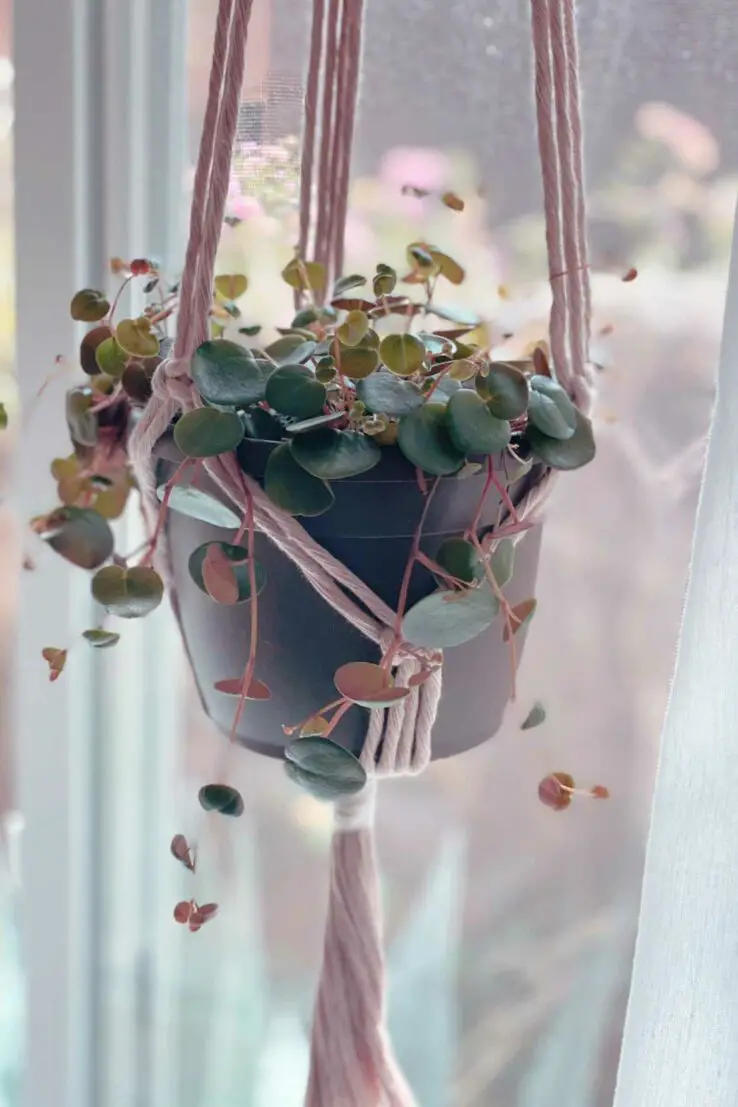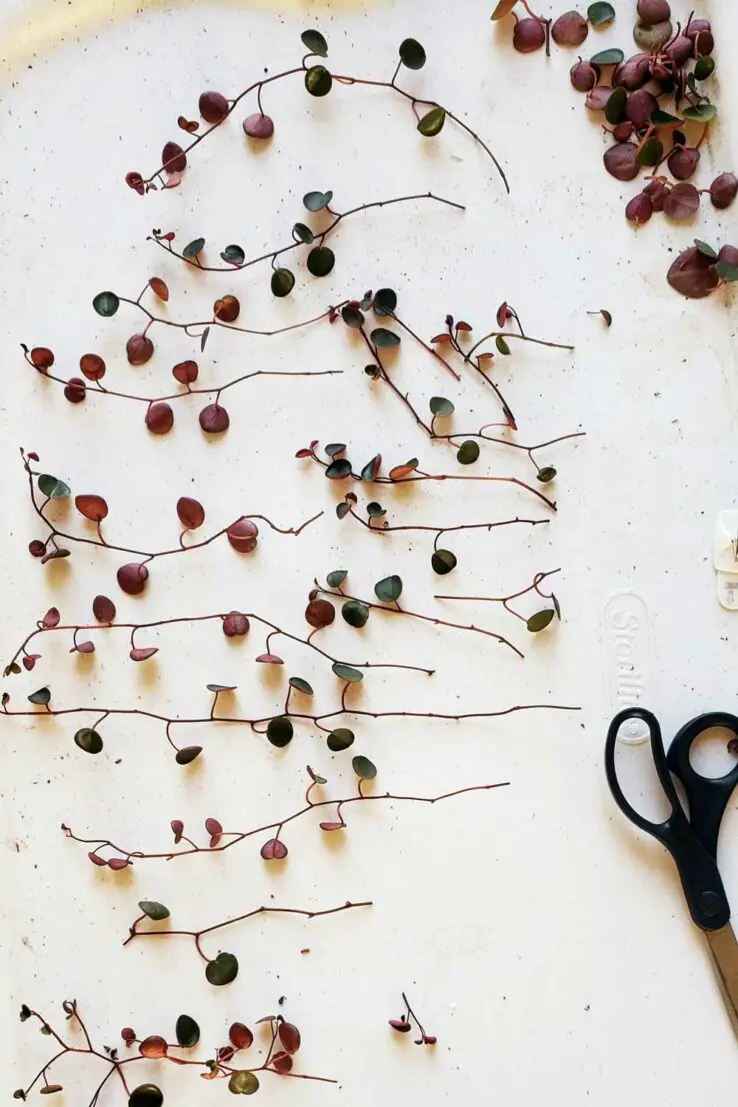Ruby Glow, Ruby Peperomia, or Ruby Cascade
Peperomia Ruby Cascade Plant
In this Peperomia Ruby Cascade Ultimate Growing Guide, you'll learn
- How to take care of the plant
- What are the plant requirements of soil, water, and light, and how to manage these like a pro?
- How to propagate by division or cuttings, using soil or only water.
- Known bugs and diseases
Details about Peperomia Ruby Cascade Plant "Ruby Glow, Ruby Peperomia, or Ruby Cascade"
Peperomia Ruby Cascade is a semi-succulent plant, with dark leaves, which is known for stunning vines and is the fastest grower among all Peperomias. It usually grows longer than most peperomias.
It is also known as Ruby Glow, Ruby Peperomia, or Ruby Cascade.
Its natural habitat is unknown. But as most Peperomias are native to tropical parts of south and central America, it might also belong to them. But it is also possible that it might be a lab-grown i.e. man-made variety.

The Ruby Cascade Peperomia plant can be grown in many conditions, even beginner growers can grow it. But it may need a slightly different approach to care for, especially in watering and soil selection.
How to grow peperomia ruby cascade plant easily?
In short, you need to take care of the following to grow the peperomia ruby cascade plant.
- Ruby Cascade needs well-draining soil because it is like succulents. You can use regular succulents and cactus soil OR you can use a mixture of indoor potting soil with pumice or perlite.
- Place this plant near a window where it gets enough indirect sunlight.
- Always water if it needs water, otherwise, leave it.
- You can also give fertilizer to fasten its growth, especially during the active growing season.
For more in-depth caring, read on...
What are the typical growing conditions/environment for the peperomia ruby cascade?
While growing the peperomia ruby cascade plant, you need to take care of the 4 important factors, i.e. Soil, Water, Light, and Nutrition.
Typical Soil for Ruby Cascade
The Ruby cascade plant is actually semi-succulent. It can store a lot of water in its leave, which can be a disaster if over-watered. So the first thing that you should take care of is the perfect soil.
Usually, any succulent soil will work. OR, any soil, that is well-draining and nutrients full will work. You can use indoor potting soil as well. But mix it with about 35% of pumice or perlite to make it more draining. Pumice will be better than perlite but might be a little bit expensive.
The extra pumice or perlite will hold moisture for a longer time, while still making the overall soil well-draining so the excess water won't dump in there. As the pumice or perlite has many small holes, it'll help make your soil airier, providing oxygen to the roots. So the plant root won't rot.
Soil selection is crucial to the growth of any plant. So don't avoid it.
How often to water Ruby Cascade Peperomia?
The best way to water the ruby cascade is to first check if it actually needs water, then water it thoroughly till it runs out of the drainage hole. OR you can put the whole pot in water, keep it for a minute there, then pull it off the water and let the water runs out of its drainage hole.
Now, you may be thinking about how to check if my plant needs water or not. That's easy. You can follow the following ways.
To check if your plant needs water, you can check the top 1 or 2 inches of soil. If it is moist, leave it to dry out, otherwise, water it. The soil doesn't need to be completely dried.
The 2nd method, which is my favorite method to check the water needs, is by checking the plant leaves themselves. Since ruby cascade is like succulents, i.e. half-succulent plant, so its leaves are thicker. If it is full of water, and you try to bend a leaf horizontally, you'll notice it a little bit thick and heavier, and like it'll break if you bend it more. But if it bends easily without showing any fragility or thickness, then it's time to water it.
You can check the actual change in the leaves in both conditions and try to remember and follow in the future. Checking plant leaves as a watering indicator is easier than checking the soil itself.
You should always avoid over-watering, because your plant may suffer from root rots.
Light and Temperature needs for Ruby Cascade Plant
The ruby cascade peperomia plant grows really well in a well-lit area. If you place it near a window where it gets enough indirect sunlight, it'll grow very fast and healthy. Direct sunlight should be avoided because it may burn your plant leaves.
If it is not getting enough sunlight, your plant may produce longer stems with fewer leaves. Although, more sunlight may make your ruby cascade leaves color brighter. So if you want to make it darker, place it in a slightly darker area. But, in a darker area, the growth may also reduce.
Ruby Peperomia plant can tolerate up to 50 °F (10 °C) temperature. But can't survive in freezing temperatures. So in winter, keep it indoors in a warm place.
In low-light conditions or in low-temperature areas, the plant-soil will need more time to dry out. It may cause root rot, eventually dying your plant. The same goes for the pot. If you use a bigger pot, the soil will need more time to dry, causing the same problem. The ruby cascade can grow easily in a medium-sized pot.
Fertilizer needs for Ruby Cascade
You can use an all-purpose fertilizer. Add about a quarter of a tablespoon to one gallon of water and always use this whenever you need to water your ruby cascade. This will help grow your plant fast, while at the same time protecting it from diseases.
No need to give fertilizer in the dormant winter season. But use it, especially in spring.
You can get this all-purpose fertilizer from amazon. It is simply best for doing its job.
Pruning Peperomia Ruby Cascade
Peperomias have amazing foliage, and the perfectly layered vines, are something that everyone will love to have. They purify the air and grow relatively fast. At times, you'll need to control your peperomias growth, or you may need to grow new plants out of the old ones. That's where pruning becomes necessary.
Peperomia ruby cascade pruning is done at the last of the fall season, or at the beginning of spring. It helps control the growth of your ruby cascade, and you'll also get cuttings for further propagation. But be careful with pruning, as excessive pruning may stop your plant's growth or even kill your whole plant.
How to Propagate Peperomia Ruby Cascade
Peperomia ruby cascade plant is easy to propagate, even beginners can do it. You can propagate it by Division, Cuttings, and Leaves. The best time to propagate the ruby cascade is from the spring to late winter. This time is its active growth season.
Propagating ruby cascade by Division
To propagate the ruby cascade plant from division, you'll need to divide your ruby cascade plant. The newly detached division should have at least 1 or 2 roots to get the best growth success rate.
Plant the detached division into another pot, and hopefully, in just about 2 weeks, you'll get a new ruby cascade plant sprouting up healthy.
Propagating by division is the fastest way to grow a new ruby cascade plant.
Propagating ruby cascade by stem or leaf cuttings

Mostly, gardeners often grow ruby cascade peperomia from stem or leaf cuttings. For this, you need to
- First, make a cutting below a node (joint) on a stem having some leaves using a sterilized scissor or knife. If the node has some airing roots, then it is best.
- Let the cuttings to callus for an hour or two. The protective callus tissues will cover the cuttings.
- Now, you can use soil as well as water to propagate these cuttings. For soil propagation, plant the cuttings in the soil so that the node gets covered, and water them.
- For the water propagation, strip down the bottom leaves, then put the cuttings into a transparent jar or bottle, so you can see the roots, and add water till it covers the nodes. But you must change the water after a week or two.
- You can also apply rooting hormone to increase the success rate and growth speed.
- In about 2 weeks, you'll see some roots growing out of the cuttings. Let them grow for a month or 45 days, then transplant them into a beautiful bigger pot.
Known Pests and Diseases
Like most indoor plants, ruby cascade peperomia also suffers from mealybug infestation. It appears like white cotton on the plant, especially on its leaves.
You can remove the mealybugs by
- A tweezer,
- OR wipe them out with an alcohol-infused cotton swab,
- OR spray neem oil on them if the infestation is moderate.
If the whole plant is full of this infestation, then it is better to regrow a new one from healthy cuttings.
The other thing that might affect or even stop your peperomia ruby cascade plant growth is placing it in freezing cold area. You should place it in a warm area.
Ruby Cascade Peperomia Plant Video
Check out an amazing video by Nick Pileggi about the Ruby Cascade plant. He demonstrates how to take good care of the ruby cascade plant.
Please, don't forget to share this guide with your friends & family as well.
Pictures credit/sources r/houseplants #1, r/houseplants #2, r/houseplantproping
Facts & Features
-
4+ ft long
This plant can grow more than 4 ft long.
-
Best for Indoor
Or keep it in a full shady area.
-
Bright Indirect Sunlight
Grows well in bright indirect sunlight.
-
Grows in Spring to Winter
Take extra care during this time.
-
Non Toxic
It's safe for humans and pets.
-
Normal Watering
Use regular succulent watering methods. Learn how to water succulents easily.
-
Not Cold Hardy
Protect from very low temperatures.
-
Pests: Mealybugs
Mealybugs appear like white cotton on the plant stem or leaves. You can remove them with a tweezer OR alcohol-infused cotton swab.
-
Propagation by offsets and cutting
Propagation by offsets is faster, but with cuttings, you can get many plants.
-
Zone 12a
In this zone, the temperature can drop up to +50 °F (10 °C)
